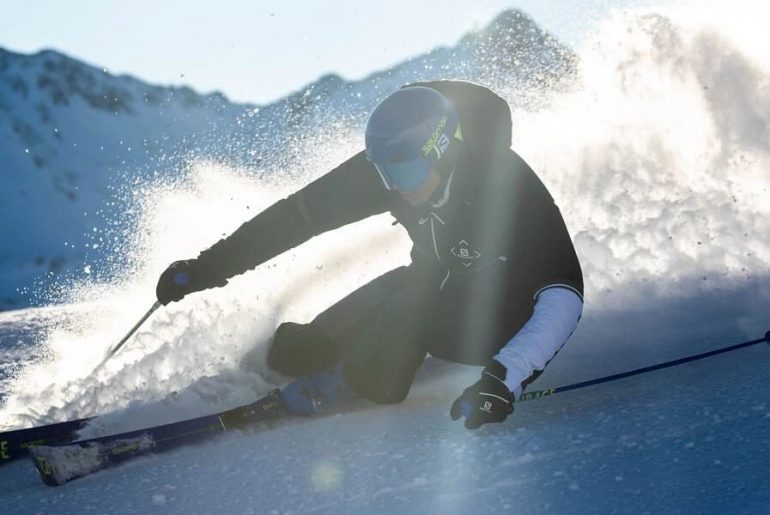This is how the alpine skiing discipline “Super-G” works
Are you interested in winter sports, especially alpine skiing and its disciplines? Very good! Here we deal with the discipline and the Super-G rules! Find out everything you need to know about them from us and shine with your knowledge at the next competition!
What does “Super-G” mean and what is it?
The Super-G is an abbreviation. It stands for the English name “Super Giant Slalom”, which means “Super Giant Slalom” in German. The discipline in alpine skiing and grass skiing is similar to giant slalom and was introduced by the FIS around 1980. The goal was to offer an additional speed discipline and that the giant slalom should again have a narrower course of the gates and thus a more technically oriented direction.
After downhill, the Super-G is the second fastest skiing discipline on specially marked slopes. The route is shorter than the descent, but technically more demanding. Compared to the downhill, there are significantly more gates, which are also closer together. In addition to the right equipment, the strength, endurance, excellent skiing technique and courage of the runners count.
The first official Super-G World Cup race for men took place on December 12, 1982 in Val-d’Isère. The first official Super-G competition for women took place on January 9, 1983 in Verbier. The first world championship races in this discipline took place in 1987 in Crans-Montana and in 1988 there were already the first Super-G Olympic champions. The Austrian Hermann Maier is the most successful Super-G rider of all time with 24 wins in World Cup races, he won the discipline rating 5 times and became world champion and Olympic champion. Another Super-G specialist was Norway’s Kjetil André Aamodt, who won Super-G Olympic gold in 1992, 2002 and 2006.
Competition rules
The rules for Super-G are similar to those for downhill skiing. The difference in altitude in Super-G races in the World Cup, Continental Cups, World Championships and Olympic Games is a minimum of 500 meters and a maximum of 650 meters for men and a minimum of 400 meters and a maximum of 600 meters for women.
At least 35 or 30 goals must be scored. These gates must be at least six meters wide and a maximum of eight meters for open gates and at least eight meters and a maximum of twelve meters for vertical gates, with a minimum distance of 25 metres. The course of the piste is usually marked with colored snow.
In contrast to the downhill, however, there are no training runs. While race participants will be able to view the course on race day, they will not be able to drive it. Like the downhill, the Super-G is also held in a single run.
Super G Goals
The Super-G gates are built to flex flexibly when touched by the rider. They are also less firmly anchored in the snow than slalom gates. As a result, they offer less resistance when a racer drives into them and are swept along by it; this minimizes the risk of injury.
Start regulations
The regulation for downhill skiing has prevailed for the starting order in the Super-G. For the World Cup downhill races, the current ten best in the world rankings can choose an odd start number between 1 and 19. Those in positions 11 to 20 in the world rankings will be drawn on the even starting numbers between 2 and 20, starting positions 21 to 30 between those in positions 21 to 30 in the world rankings.
What gear do you need for Super-G?
Since the Super-G is also primarily about speed, the equipment for this sport is almost identical to that for downhill skiing. With speeds of up to 130 km/h, the right equipment is a must to avoid serious injuries. The helmet in particular is indispensable – and that applies to both professional and amateur athletes.
- ski helmet
- sticks
- ski boots
- ski suit
- glasses
- gloves
- ski
In some Super-G races, athletes have to choose between the fast downhill skis or the slower giant slalom skis.
Suit and protections
Super-G racers wear skin-tight ski suits to minimize drag. However, the material must have a precisely defined air permeability. Each race organized by the International Ski Federation (FIS) only allows suits that have been previously checked by the FIS and provided with a seal on the left leg.
Ski helmets and back protection are also required for races, as well as goggles and gloves.
Ski poles
In the downhill and in the Super-G, ski poles are often only used to keep your balance, which is very important in the tight and fast curves and at high speeds. Ski poles are made from a lightweight material such as aluminum or carbon. A ski pole tube has a diameter of about 1 to 2 centimeters and is slightly curved, as it offers less air resistance. There are loops on the handles for a secure hold. At the bottom of a pole there is a plate that ensures that the ski poles do not penetrate the snow very deeply. The shape of the plates, the sticks and their length differ somewhat for the specific ski disciplines.
Ski boots
The right ski boots are necessary for optimal power transmission from the foot to the ski. Ski boots are of solid construction and are usually made of plastic and composite materials. Racers prefer hard to very hard ski boots that are narrow and narrow. In this case, comfort is of secondary importance, but the optimal individual fit counts. The flex index is used to indicate the degree of hardness, the higher, the harder the shoe. Ski boots for racers have a flex index of 150.
There are also differences between men’s and women’s ski boots: Due to women’s lower calves, the shaft of the ski boots is slightly lower.
Ski models for Super-G
The ski models used for giant slalom and super-G are longer and stiffer than slalom skis. A downhill ski is 30 percent longer than a giant slalom ski, providing additional stability. The radius is also important. A radius specification refers to the natural radius of the ski. For the measurement, the ski is placed on its edge and bent so far that the edge lies continuously on the ground. The natural curve radius of a ski can be calculated from this curved line. According to the FIS, the radius of a giant slalom ski must be 30 meters and the sidecut 35 meters. The minimum length is 193 centimeters for men and 188 centimeters for women.
Super-G and grass skis
The Super-G is the youngest and fastest discipline in grass skiing and was first held in 1987 as part of a world championship. Similar rules apply here as in alpine skiing. However, due to a lack of suitable slopes, there are no downhill runs for grass skiing. However, it is planned to carry out so-called sprint descents.
The difference in height of a Super-G slope for grass skis is 120 to 180 meters for men (at least 100 meters in exceptional cases) and 110 to 150 meters for women (at least 90 meters in exceptional cases). The starting order is based on the FIS points, with the 15 best-placed runners being allocated the top starting positions, all others start in the order of their FIS points. The course is inspected before the race and there is only one run.
What is the difference between downhill and super g in skiing?
The super-G stands for super giant slalom, an event that combines the speed of downhill with the more precise turns of giant slalom. There’s less of a vertical drop than the downhill and gates are placed closer together. Each skier makes one run down a single course and the fastest time wins.





